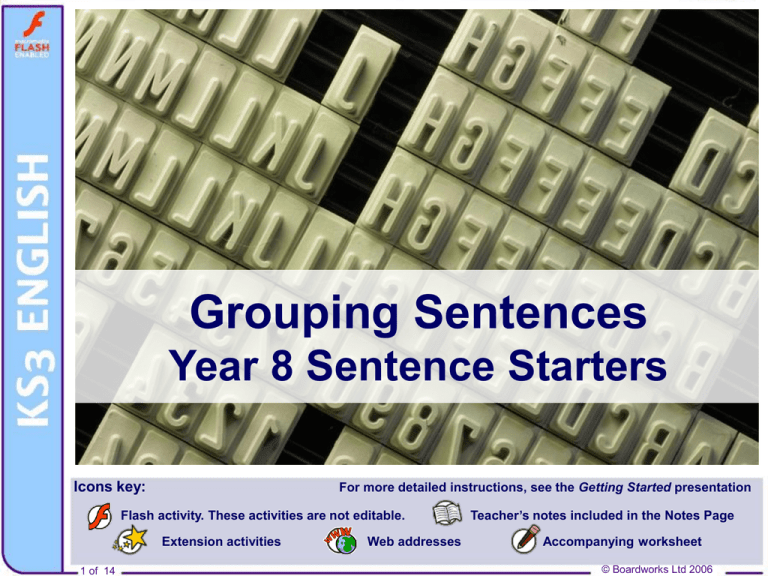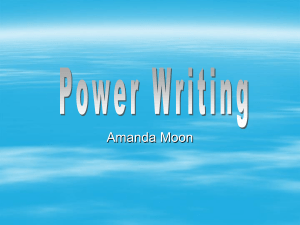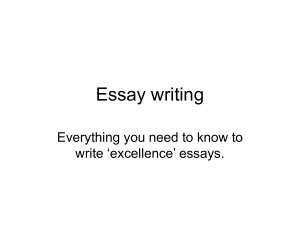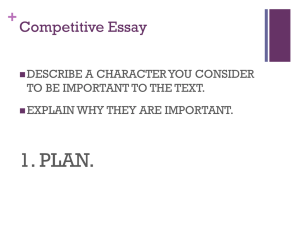Grouping Sentences
advertisement

Grouping Sentences Year 8 Sentence Starters Icons key: For more detailed instructions, see the Getting Started presentation Flash activity. These activities are not editable. Extension activities of 14 11 of Web addresses Teacher’s notes included in the Notes Page Accompanying worksheet © Boardworks Ltd 2006 Contents In this unit you will… Revise topic sentences Learn how to group sentences in paragraphs chronologically Develop paragraphs using comparisons Give examples to develop paragraphs Consider how to structure a series of paragraphs Write your own series of paragraphs of 14 14 22 of © Boardworks Ltd 2006 Writing non-fiction paragraphs No, I knowHave what you I want to Hi Megan! finished say but I’m not sure to your history essay yethow on the structure my paragraphs. Romans? Can you help me? Nearly. Yes, of Have course you I’ll finished help you.it? Let’s look at a non-fiction paragraph… 3 of 14 © Boardworks Ltd 2006 Beginning non-fiction paragraphs Read Megan’s paragraphs. What do you notice about them? The Roman Classical empire Roman Empire Empirewas wasthe thelargest largest Classical empire in the still visible today. It the world worldand andits itseffects effectsare are still visible today. spanned from 31 31 BC,BC, after Julius Caesar wonwon thethe It spanned from after Julius Caesar civil war against Pompey, to AD 1453. The Roman Empire controlled most of Western Europe, parts of Northern Africa and some of the Middle East – 2.3 million square miles in total! The population governed by Roman rule is not known but it is estimate estimatedtotobe be anywhere between 55 and over 120 million people. Historians argue first emperor: argue over overwho whowas wasthe the first emperor: Julius Caesar know as as Augustus). Caesar or orOctavian Octavian(later (later know Augustus). Julius Caesar was know as Dicatator Perpetuus… Each paragraph begins with a topic sentence. 4 of 14 © Boardworks Ltd 2006 Topic sentences Yes, it’sknow a sentence Do you what a which topic sums up what your sentence is Max? paragraph is going to be about... Um, is it a sentence about a topic? Topic sentences are the best way to open non-fiction paragraphs because they sum up what the paragraph is going to discuss. They signpost to the reader the subject of each paragraph, making your purpose clear. Try to write five topic sentences which Megan could use in her essay. 5 of 14 © Boardworks Ltd 2006 Grouping sentences Did you know that the body of a paragraph needs to support the opening sentence? That’s called the topic sentence, right? In non-fiction, paragraphs usually begin with a topic sentence which introduces what the paragraph is about. You can develop paragraphs by grouping the other sentences to: 1. Describe an idea chronologically. 2. Make comparisons of ideas or things: use connectives to show similarities and differences. 3. Use examples to strengthen an idea or argument. 6 of 14 © Boardworks Ltd 2006 Writing chronologically Writing chronologically means describing an idea or event in the order that it occurs, e.g. The egg will hatch into a chick and then grow into a chicken. When might you need to describe something chronologically? Try to write a short paragraph describing an event chronologically. 7 of 14 © Boardworks Ltd 2006 Grouping sentences chronologically 8 of 14 © Boardworks Ltd 2006 Making comparisons 9 of 14 © Boardworks Ltd 2006 Comparing people Write a paragraph to compare these two people using some connectives. Then share your ideas with the class. What is similar? What is different? When might you need to make comparisons? 10 of 14 © Boardworks Ltd 2006 Using examples in paragraphs 11 of 14 © Boardworks Ltd 2006 Using examples Think of a controversial topic. You may use an idea from the box below or think of your own (but ask permission first!). School uniform Fox hunting The death penalty Motorway tolls Think of an argument in favour of one side of the debate and sum it up as a topic sentence. Add more sentences to give examples to argue your point of view. Then use a connective to discuss the other side of the debate. 12 of 14 © Boardworks Ltd 2006 Writing paragraphs So far we have considered three ways of grouping sentences in paragraphs. You are now going to generate a series of paragraphs. Use the following guidelines: introduce each paragraph with an informative topic sentence make sure that the rest of the paragraph supports your topic sentence think about ways to develop your sentences, such as using relative and adverbial clauses arrange the sentences within your paragraphs in the best order: 1. chronologically 2. by making comparisons 3. by using examples use your last paragraph to sum up the information. 13 of 14 © Boardworks Ltd 2006 Writing a series of paragraphs Do some research on orangutans and then using your notes and the images above write a ‘documentary’. You can use the pictures in any order but you must write connected paragraphs. 14 of 14 © Boardworks Ltd 2006






